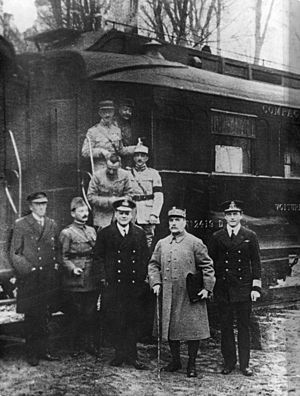Armistice with Germany (Compiègne) facts for kids
An armistice treaty is like a ceasefire or a truce. It's an agreement to stop fighting in a war. The armistice that ended World War I between the Allies and Germany was signed on November 11, 1918. This important event happened in a special railway carriage in the Compiègne Forest in France. It marked the end of the First World War on the Western Front.
The main people who signed it were Marshal Ferdinand Foch, who was the top commander for the Allies, and Matthias Erzberger, a representative from Germany. The agreement was made at 5 AM on November 11, but the fighting officially stopped at 11 AM Paris time. This is why we often remember "the eleventh hour of the eleventh day of the eleventh month."
Before the signing, on November 7, 1918, the German commander, Paul von Hindenburg, asked Ferdinand Foch for a meeting. Germany was facing a lot of unrest and pressure for change in cities like Berlin and Munich.
Who Signed the Armistice?
Many important people were involved in signing the armistice.
For the Allies, all the people were military leaders:
- Marshal of France Ferdinand Foch, who was the supreme commander for the Allies.
- First Sea Lord Admiral Rosslyn Wemyss, who represented Britain.
- General Maxime Weygand, who was Foch's chief of staff.
For Germany, the group included both military and civilian leaders:
- Matthias Erzberger, who was a politician.
- Count Alfred von Oberndorff, from the German Foreign Ministry.
- Major General Detlev von Winterfeldt, representing the German army.
- Captain Ernst Vanselow, representing the German navy.
The peace that officially ended the war and followed this armistice was called the Treaty of Versailles. It was signed in 1919.
Images for kids
-
Front page of The New York Times on Armistice Day, November 11, 1918.
-
Photograph taken after reaching agreement for the armistice that ended World War I. This is Ferdinand Foch's own railway carriage in the Forest of Compiègne. Foch's chief of staff Maxime Weygand is second from left. Third from the left is the senior British representative, Sir Rosslyn Wemyss. Foch is second from the right. On the right is Admiral Sir George Hope.
-
The declaration of the Republic at the Reichstag building on November 9.
-
Painting depicting the signature of the armistice in the railway carriage. Behind the table, from right to left, General Weygand, Marshal Foch (standing) and British Admiral Rosslyn Wemyss and fourth from the left, British Naval Captain Jack Marriott. In the foreground, Matthias Erzberger, Major General Detlof von Winterfeldt (with helmet), Alfred von Oberndorff and Ernst Vanselow.
-
Commemorations at the Arc de Triomphe in Paris on November 11, 2018, remembering 100 years since the end of the war.
See also
 In Spanish: Armisticio del 11 de noviembre de 1918 para niños
In Spanish: Armisticio del 11 de noviembre de 1918 para niños














